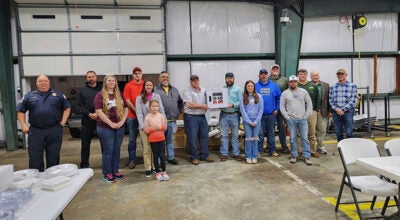COVID-19 patients keeping area ICUs busy
Published 2:15 pm Friday, March 5, 2021
|
Getting your Trinity Audio player ready...
|
In a normal year, about five million people are admitted into hospital intensive care units, and on average, they are about two-thirds full, according to the Society of Critical Care Medicine.
This has not been a normal year between COVID-19 and patients delaying care for other illnesses, keeping ICUs across the country full. It has been no exception in Western Tidewater and Hampton Roads.
COVID-19 has ravaged the world’s population, and in the United States, has killed more than 500,000 people in the past year — a milestone President Joe Biden marked with a moment of silence.
In Virginia, it has killed 8,197 people as of Feb. 26.
In the Western Tidewater Health District — inclusive of the cities of Suffolk and Franklin and Isle of Wight and Southampton counties — it has taken the lives of 276 people.
Suffolk has seen 150 people, alone, die from COVID-19, another 51 have died in Southampton, 49 in Isle of Wight and 26 in Franklin.
Its strain has been felt most acutely in the ICU, and at hospitals throughout South Hampton Roads and Western Tidewater, they started reaching capacity levels in late January and at several, they have not eased up.
According to the Virginia Hospital and Healthcare Association, ICU occupancy at hospitals in the state stands at 80% as of Feb. 26, but including surge bed capacity — or as defined by the federal Department of Health and Human Services, areas that can “provide adequate medical evaluation and care during events that exceed the limits of the normal medical infrastructure” — it’s at 52%.
Pre-COVID-19, ICU capacity at state hospitals averaged about 67%, according to the VHHA. As of Feb. 26, there are 1,481 confirmed positive COVID-19 patients, or those whose test results are pending, in the hospital, with 313 in the ICU and 187 on ventilators.
Dr. Mike Dacey, president and chief operating officer at Riverside Health System, noted that the peak census across Virginia at the beginning of the month was about 3,000 hospitalized patients with COVID-19 and 600 in the ICU, and in the Eastern Region, it was 800 hospitalized and about 150 in the ICU.
ICU capacity has been at around 80% or higher at several regional hospitals over the past several weeks, making them among the fullest, percentage-wise, in the state.
The ICU at Sentara Obici Hospital in Suffolk is at 101% capacity — the highest in Virginia — with 33 COVID-19 patients and no available beds, according to the most recent data being from the week updated Feb. 21 — inclusive of Feb. 12 through Feb. 18 — by the federal Department of Health and Human Services. Its data is updated weekly.
Bon Secours’ Southampton Memorial Hospital in Franklin has also seen ICU capacities at or near 100%, though it is currently at 73% capacity with six COVID-19 patients and two available beds.
Chesapeake Memorial Hospital, meanwhile, has 64 COVID-19 patients, just two available beds in its ICU and is at 92% capacity. It, too, has at times been overcapacity since the start of the new year.
COVID-19 cases and hospitalizations may be decreasing after a holiday surge, but capacity is still an issue among those with more serious symptoms and non-COVID-19 patients who are coming into hospitals with more acuity due to delaying treatment.
Obici not turning anyone away
At Sentara Obici, it has added capacity to its normal, 12-bed ICU, but according to Sentara Healthcare spokesman Dale Gauding, it has not had to divert ambulance traffic to other hospitals, and has no plans to do so.
“Sentara Obici … and those at other Sentara hospitals often operate close to capacity in normal times,” Gauding said in a statement. “The way we address COVID-19 challenges is by flexing other spaces and putting bedside equipment where it is needed to serve critical care patients.”
Gauding said that can include a post-anesthesia care unit, or a step-down unit that transitions patients from the ICU to regular beds.
Even increasing to 16 beds, Sentara Obici’s ICU has been overcapacity for five out of the last six weeks — with roughly half of its ICU each week filled with COVID-19 patients except for the most recent week reported, in which it was about a quarter-full of such patients.
“Our teams have responded with determination, resilience and support for each other,” Gauding said.
Some Sentara hospitals have postponed non-emergency and elective surgeries to allow for more capacity in its ICUs and its post-anesthesia care units for COVID-19 patients, and nurses who normally work in elective surgery operations may be temporarily deployed to other departments, in particular when its staff have to quarantine at home.
“It is a daily process of adjusting to patient needs and creative use of space and staffing to ensure the sickest patients receive the care they need,” Gauding said.
Southampton Memorial leveraging its Bon Secours connection
At Southampton Memorial, it has been near capacity in its ICU, which has eight beds. While its weekly averages have not put it at or overcapacity to this point, it has stayed busy.
During the week of Feb. 5 through Feb. 11, its ICU was 96% full, with its seven-day average of ICU beds used at 7.7 of the eight that were staffed, though it reported fewer than four COVID-19 patients. In the two weeks prior to that, more than 70% of those patients had COVID-19.
Its president, Kim Marks, did note that it had many 100% capacity days.
“Over the last few weeks we have seen a surge in our ICU level of care,” Marks said, “… and many days, we were 100% capacity within our ICU.”
She said when it has had surges or when a patient is beyond Southampton Memorial’s capabilities as an acute care hospital, it has been able to leverage other Bon Secours hospitals, along with out-of-network hospitals in Hampton Roads, to provide care.
Marks said the hospital has had what it’s needed to treat COVID-19 patients, from mononuclear antibodies, to steroids, to remdesivir, along with increasing the number of ventilators it has on hand, BiPAP (Bilevel Positive Airway Pressure) machines and converting a number of the rooms on its med-surg floor to negative pressure rooms to accommodate the increase in COVID patients. She said it has additional areas of the hospital it can convert to ICU bed spaces if needed.
And though the hospital has postponed elective procedures previously, Marks said it is not doing so now, and said its staff has performed admirably while working extra hours over the past year “to deliver what we call high-quality compassionate care through this unprecedented time.”
“We have been able to continue to provide elective surgeries here at the hospital over the last few months,” Marks said, “in addition to taking care of the heavy load of ICU patients.”
Like other hospitals across the country, Southampton Memorial has seen more severe COVID-19 and non-COVID-19 illnesses.
“We have continued to see a high acuity of patients with COVID, and those without COVID during this period of time,” Marks said. “Our current COVID activity is better today than it was two weeks ago, as we’re seeing in our community infection rate.”
Riverside, state trending ‘downward … but they’re still dramatically higher’
Dacey noted the downward trend in cases, hospitalizations and ICU usage generally, but it is still “dramatically higher” than it was during the summer spike.
“The problem with COVID, it is still a problem in the intensive care unit utilization because the patients stay a long time,” Dacey said. “Once you get intubated or COVID, you’re on a ventilator on average for approaching two weeks.”
Dacey said if someone is not on a ventilator, the ICU stay is typically about 10 days, but that is still compared to a normal ICU stay of about four days.
“It’s dramatically higher, and so they stay a lot longer in the ICU,” Dacey said. “The good thing is, compared to the summer … as the percentage of the total COVID population, fewer and fewer of them are in intensive care units. They’re able to be taken care of outside the ICU and on regular medical floors.”
That’s due to more effective treatments than earlier in the pandemic, such as steroids, remdesivir and, to some extent, Dacey said, antibody treatments that Riverside has been using.
“We’ve seen our overall hospital census fall by 50%, about 120 to 60 (people),” Dacey said. “Our ICU census has fallen from about 35 (people) to about 12 right now over the course of the last three weeks.”
This week, at Riverside Regional Medical Center in Newport News, its ICU was at 78% capacity, with 44 COVID-19 patients and 15 available ICU beds.
Dacey said that, like other hospitals, Riverside can work within its system, and with other systems, to ease patient loads.
“We send patients back and forth all the time for ICUs and that, by the way, is not uncommon,” Dacey said. “That happened during regular times as well. Each health system has a transfer center and they coordinate that so if Riverside is full and has no capacity, the patients may go to Sentara and vice versa.”




